Are you a good assistant during a Kite launch and landing?
On any kitesurfing beach, you can see many examples of how to correctly or incorrectly give assistance in the kite launch. A few tips to ease the kitesurf launch and landing.
It is true that nowadays many experienced riders even opt for self-launching their kite, but in difficult conditions or for not experts, assisted launch it is a must.
A good kitesurfer should also be a good assistant to others, especially helping not expert riders who can still make mistakes, but sometimes this doesn’t happen. Let’s see together how to help to launch the kite in the best way in case we encounter an inexperienced rider and, if you are that guy, you can read my previous post on how to carry out an assisted launch in safety as the pilot here.
* The first important role of a kite assistant is to check the lines and bridle system for the presence of any tangles or wrong lines connections. In that case, he should abort the launch, regardless of the indications of the pilot to continue. Checking the kite size according to the wind intensity and the rider's weight is also a very recommendable practice. If all is ok he can proceed in assisting the kiter to the launch.
** The second important thing we should check is the presence of people or obstacles downwind for a reasonable distance. This should definitely be done by the pilot, but inexperienced and excited riders may overlook crucial details and we should support them properly, even denying the launch in dangerous situations.
The well-known theory says we should launch the kite at the border of the wind window, keeping the kite high enough for the canopy not to touch the ground and holding the kite not to close to the wingtip, to avoid to make it too unstable and slip out of the hands:
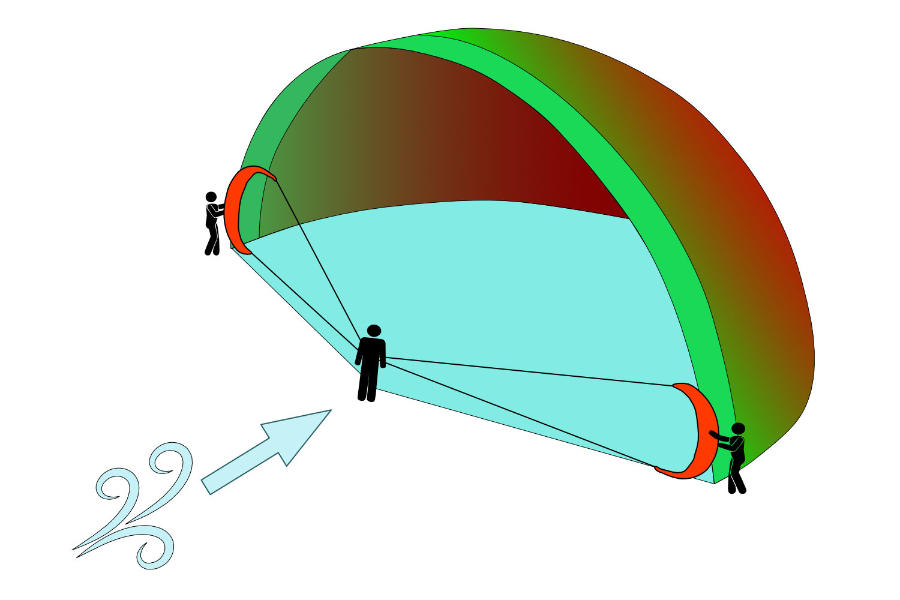
This is crucial because, if we miss the border, we can find ourselves in two different situations:
- launch the kite from the power zone (the red area of the window): we start experimenting with big pressure on the kite while trying to hold it and the pilot will have to face some unwanted power from the kite, while not yet ready to pilot it.
- launch the kite out of the wind window (upwind respect to the pilot position): there won’t be pressure on the internal side of the kite’s canopy to put in tension the lines. After its release, the kite will fall on the ground, it will possibly drift back or even roll until it will be deep in the power zone. At that point the lines’ tension will suddenly stop the kite, which will regain wind pressure on the canopy, resulting in a quick restart with great pull on the pilot.
The experienced kiter, when he is on the beach with someone’s kite in the hands, knows how to find the sweet spot of the border of the wind window. If the pilot is skilled and places himself in the correct position no action is needed from the assistant, but this skill is particularly important when the kitesurfer we are helping isn’t an expert and misplaces himself in relation to the kite and the wind window positions.
The method of the compass will help with that: It consists of keeping the kite lines in tension, moving along the circle they force us to follow, and observing the kite behavior.
1. If we are out of the wind window close to being upwind to the kiter’s position, the kite will have its canopy waving like a flag (flapping). We can see the difference in the following image, where on the left the kite is out of the wind window and is ‘flapping’, while on the right, it is inside the wind window and the canopy is held straight and in tension by the wind pressure:
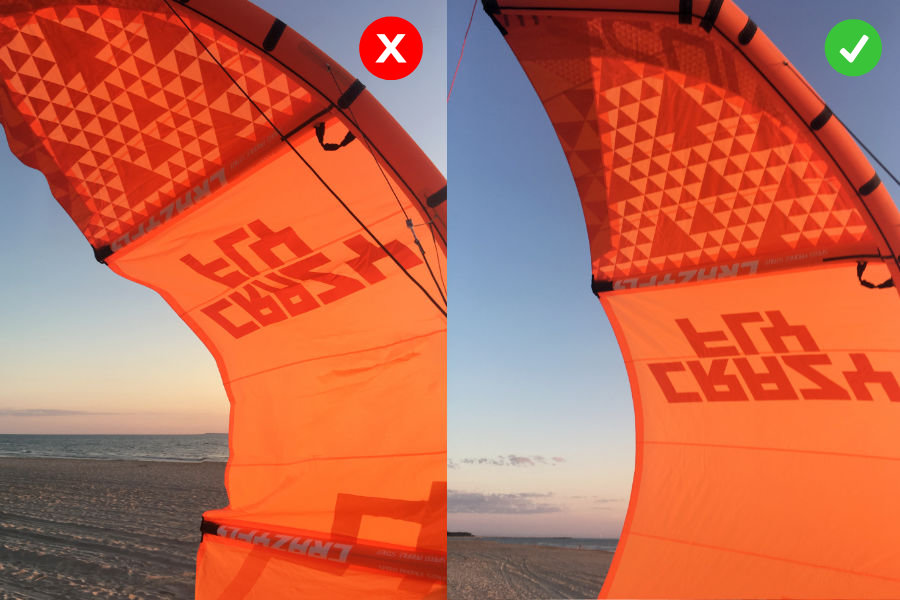
2. On the opposite side, if we are deep in the power zone the kite will push us and the kiter with a lot of pressure: we need to move upwind to get out of the power zone. You can see an example in the following image where the kiter and the launch assistant are struggling to hold the kite pull since its position is too deep in the wind window.
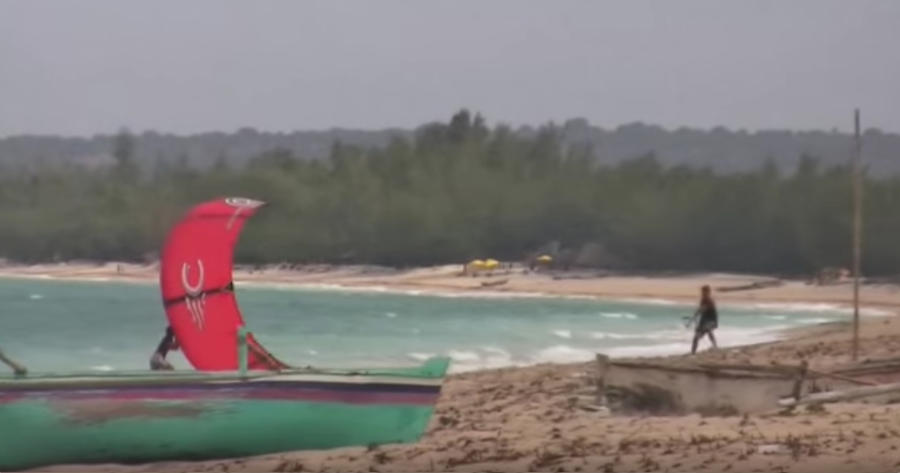
The compass method can be simplified as in the image below. It is needed to just check the kite behavior and act in the corresponding proper way:
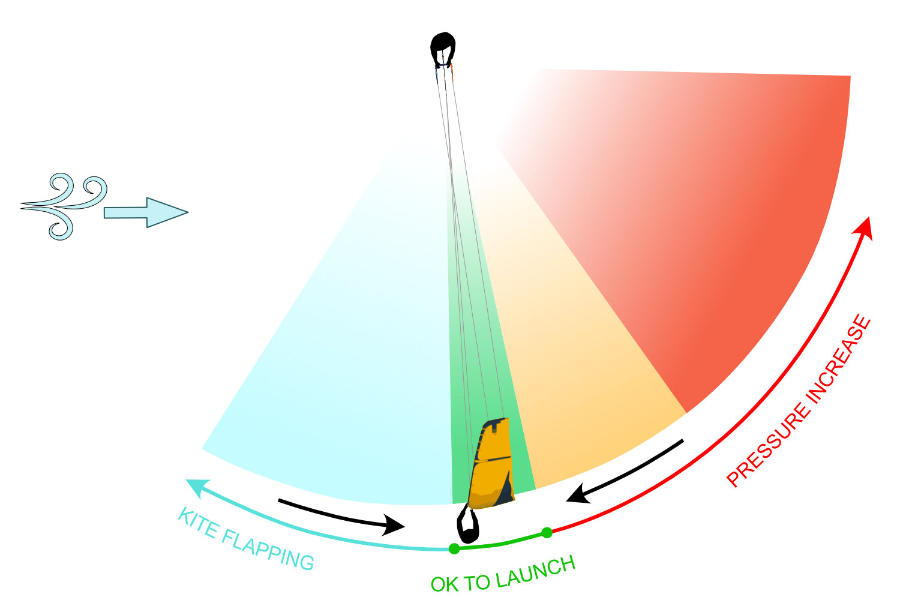
If you feel too much pressure on your hands from the kite, you want to walk in the upwind direction until the pressure is reasonable, indicating the kite is correctly powered and ready to be launched.
On the contrary, if the kite is flapping and you have to hold it to keep it in the proper vertical position, it means you are too upwind compared to the rider position. You need to move downwind until the kite stops flapping. After that continue a step or two downwind to make sure the kite is properly engaged by the wind and has the needed power to be launched easily
An important note as launch assistant: when the rider gives you the thumb up (international launch sign) or any non verbal pre-agreed communication confirming he is ready, just let the kite go and step backward.
Many times people with the best intention push the kite up and forward:
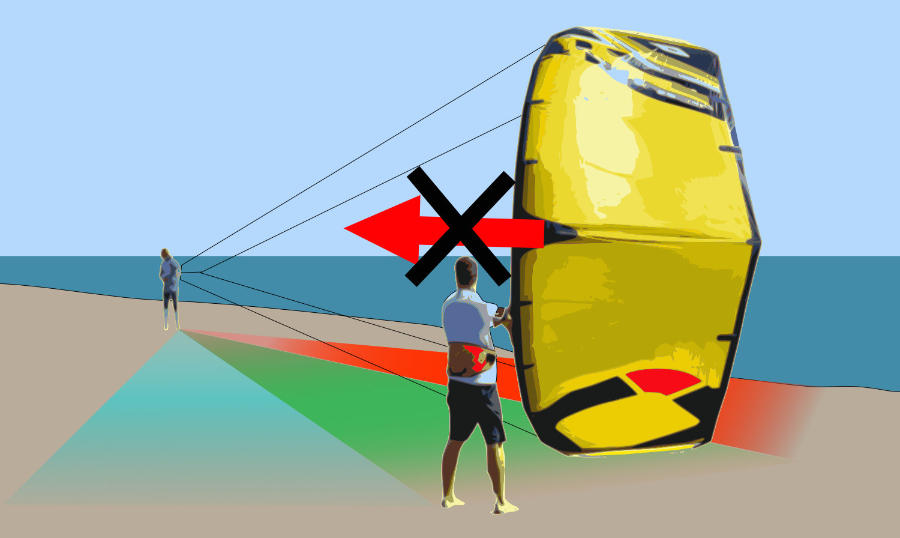
This is not a good practice, because the kite might go out of the border of the window (green area) to end up upwind (azure area) where we just explained it won’t fly and fall back dangerously in the power zone.
A little trick in the landing phase to ease the kiter and yourself is to catch the kite in the center of the leading edge and walk towards the kiter immediately before or while putting the kite from vertical to the ‘smile’ position.
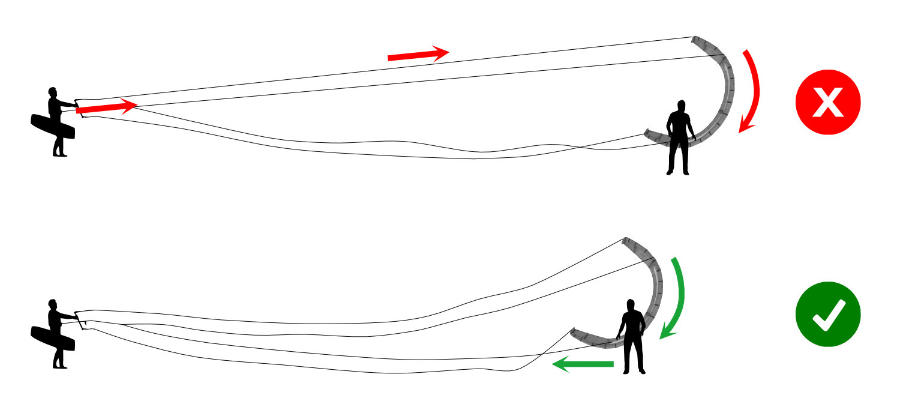
In this case many times it happens that the assistant to the landing just flips the kite, pulling the lines and the rider. Normally it doesn’t create much of a danger. Yet it is uncomfortable for the rider who gets pulled towards the kite.
Of course, all that's written above is applicable if the pilot shows a sufficient level of capacity in the use of the bar, the correct sensitivity managing the line tension, and good control of the kite in prelaunch. if any doubt or misunderstanding arises during the launch or the communication between the pilot and the assistant is difficult, it is better to put back the kite on the ground and clarify the situation.
I hope this post will be helpful. Comment below with your impressions or if you have any suggestions or remarks on this topic, we really appreciate the contribution of everyone.

Flowy T-Shirt

Logo: When life gives you wind go kiting!
Promote your Kite School for free!
Index your Kite School in our database.
You will get free lifetime visibility on Kitesurf Culture website.
If you have a website, it will provide precious backlinks to improve your SEO ranking
Relevant Posts
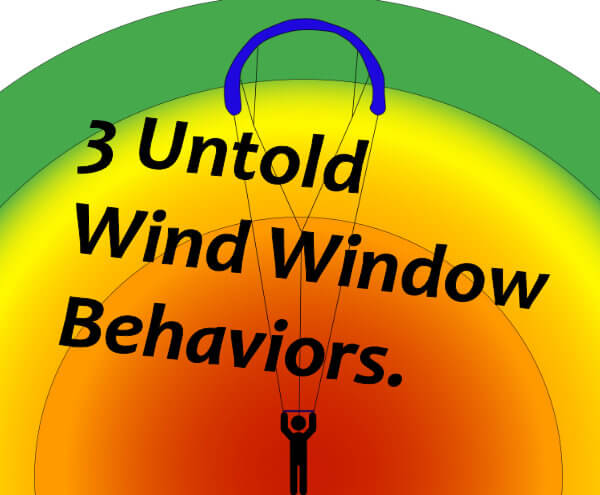
3 Untold Wind Window Behaviors.
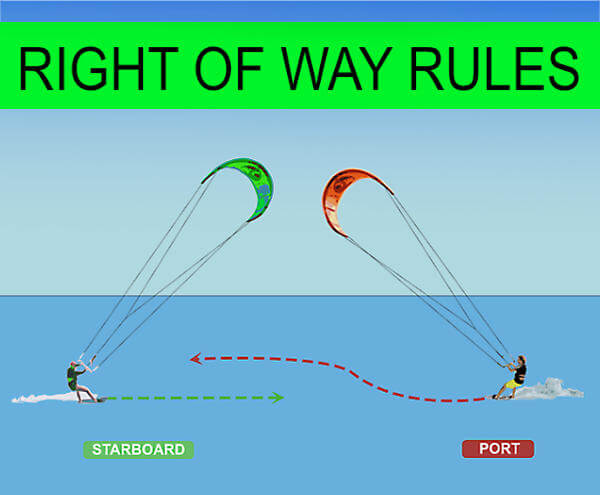
Guess what?! Kitesurfing right of way rules!

12 Tips to Correctly and Safely Launch and Land Your Kite
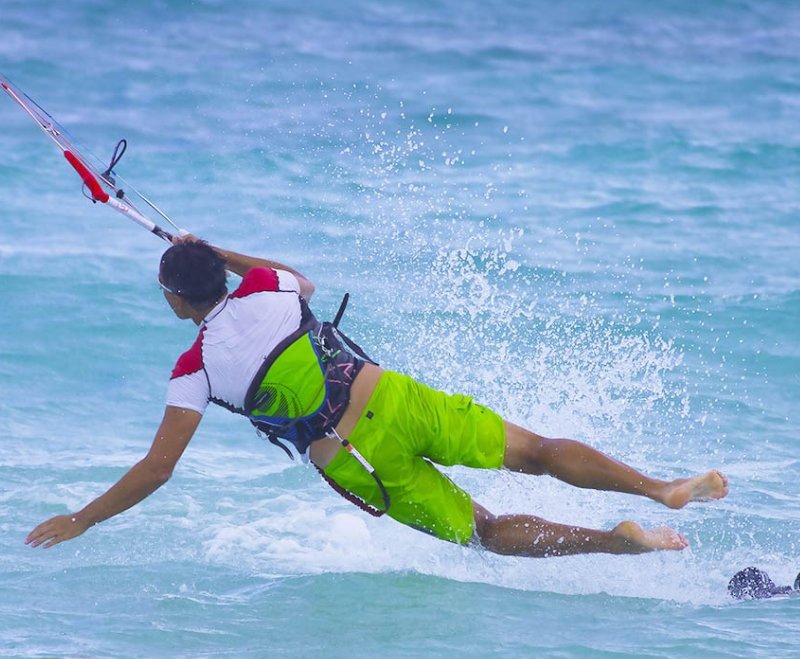
How To Overcome The Fear Of Kitesurfing
Get free Kitesurfing Resources and Tips
If you like our content and you want to be informed on the next blogposts release, please subscribe here. That will also help us to continue to provide quality content:
Give us your opinion.
Comments
Peter
Very helpful. As an intermediate rider I recently had a kitemare whilst launching in an unfamiliar spot and destroyed my new kite in a tree. At first I couldn't understand what had happened but now realize that my assistant and I were not in the correct place and the kite was infact too far upwind without enough pressure in the kite. When my assistant released the kite it moved forward and then rotated out of control into the power zone. The rest is history as is my kite. Just shows you can never be too careful and never launch in an area that has obstacles or tree's etc. Survey the launch site carefully and make sure you have enough room to launch safely.
2 years ago
Answers :
Gabriele
Thank you, Peter. I am really happy you appreciate the post!
2 years ago
Ivo
Good one. Thx.
6 years ago
Martin Goettsch
That was very helpful as a person new to the sport & also a photographer willing to help our subjects get into the wind
6 years ago
Steve Burkey
Excellent description and graphics. All of this works perfectly if the rookie kiter maintains some moderate tension on all 4 lines. But many times that is not the case. These examples do not work if the kiter doesn't understand that he/she is in control of line tension
6 years ago
Answers :
Gabriel
Thanks, Steve, I agree with you. I would indeed think that if the kiter isn't able to control the line tension during the lauch, he/she should definitely get back to have some lessons, before attempting to ride independently. :-)
6 years ago
Christian Bulota KiteBud
If the pilot isn't experienced enough then the pilot must get trained to do it the correct way. It's by educating the pilots properly that you we would see the safest launching habits, not by asking assistants to move around :( Your solution may be a quick fix but in the long run it's not helping making the sport any safer
6 years ago
Steve Burkey
Christian, My point was only that the pilot must understand his roll. The assistant cannot correct for that. I felt that the original (excellent) article lacked getting that point across. However, I think all the graphics and explanations in the original are very accurate and would help a rookie pilot understand the process and how wind angles between the pilot and assistant affect the outcome. I didn't write the original, and only suggest that the original COULD have included (for the benefit of the pilot) that it only works if/when there is moderate tension on all four lines. I don't think the creators of the original saw this as a shortcut. And I disagree with you about safety. This illustration and explanation will definitely make the sport safer. Everybody was a rookie once upon a time. If you (the experienced kiter) are to offer launch assistance for someone, the goal is a safe launch.
6 years ago
Gabriel
In an ideal world Christian, you are 100% right. In real life, you don't launch the kite, probably the kiter will ask someone else. Also, the fact that you launch an inexperienced pilot helping him safely doesn't exclude you can teach the proper way or suggest him to get better training on the matter. Normally people, after you help them, are more prone to listen to good advice. Just dropping the kite on the ground and telling the rider he needs further training and blocking him to is session, might also arise an argument. I find your position a bit of an integralist one. But you are for sure intitled to it. Let's agree to disagree :-) But thank you for your point of view, this kind of discussion are very important: they improve the overall safety of the sport, creating awareness on critical points often overseen.
6 years ago
Christian Bulota KiteBud
Hi Gabriele, this a great effort and some great graphics in your post. However, the assistant is definitely not the person who should be moving around while holding the kite unless the pilot specifically ask the assistant to do so (lack of space for example). The pilot is always entirely responsible for finding the correct position in the wind window prior to the launch, not the assistant. Furthermore, a lot of accidents happen during launching due to tangled bridles or a mistake in rigging, this is when the assistant can play a critical role by checking for any obvious tangles and giving the pilot a thumbs up prior to getting the thumbs up from the pilot. This would make assistant launching a lot safer. You can read all about this here https://www.kitebud.com.au/kitesurfing-online-courses/launching-landing/
6 years ago
Answers :
Gabriele
All very good points Christian, thank you for the comment. The post though is not talking about the "according to manual" kite launch, but in the specific case when the pilot isn’t experienced and has difficulty handling and direct the launch by himself. Haven’t you ever found yourself in that situation? It occurred to me very often. Good point about the line check I overlooked it: I added that marked with (*)! Thanks for your great contribution
6 years ago
Flowy T-Shirt

Logo: When life gives you wind go kiting!
Promote your Kite School for free!
Index your Kite School in our database.
You will get free lifetime visibility on Kitesurf Culture website.
If you have a website, it will provide precious backlinks to improve your SEO ranking
Relevant Posts

3 Untold Wind Window Behaviors.

Guess what?! Kitesurfing right of way rules!

12 Tips to Correctly and Safely Launch and Land Your Kite

How To Overcome The Fear Of Kitesurfing
Men's Performance T-Shirt

Logo: Kitesurfing making gravity optional since 1977
Latest Posts

Kitesurfing Dubai: an honest guide. Tips, Spots & Winds
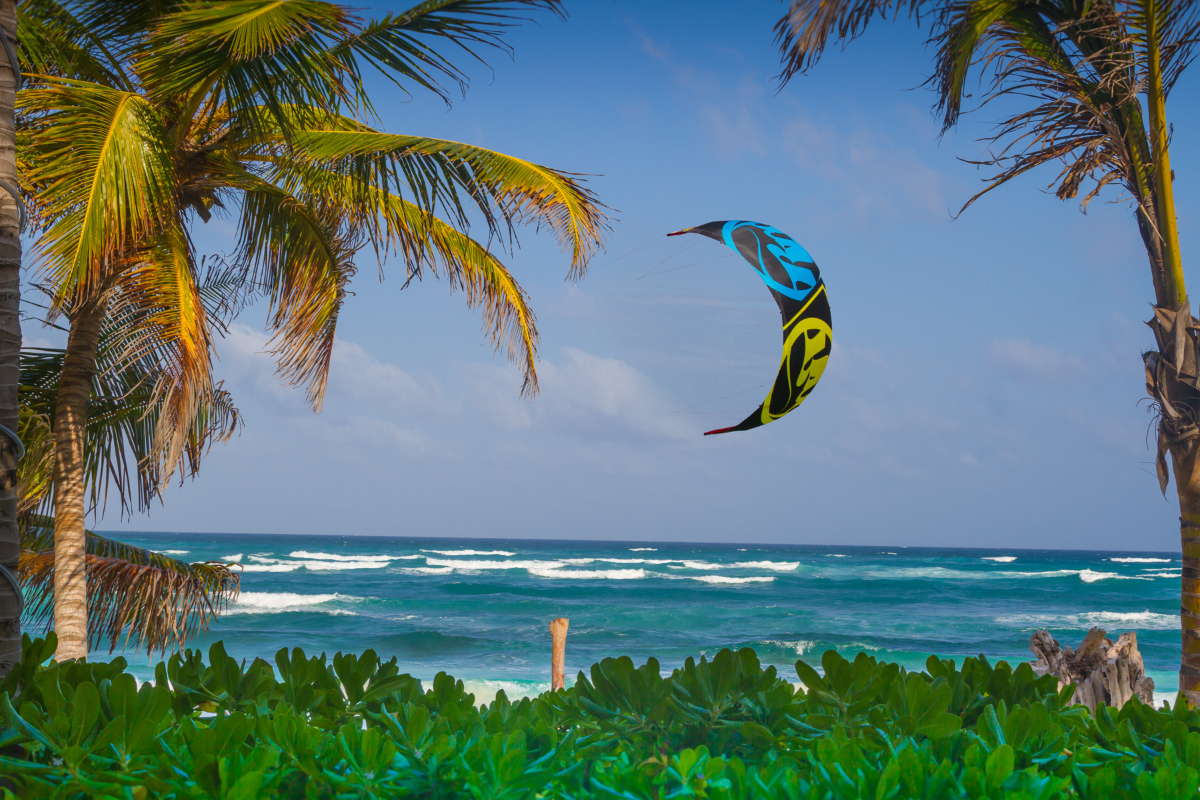
Unwind and learn: best beginner kitesurfing spots worldwide
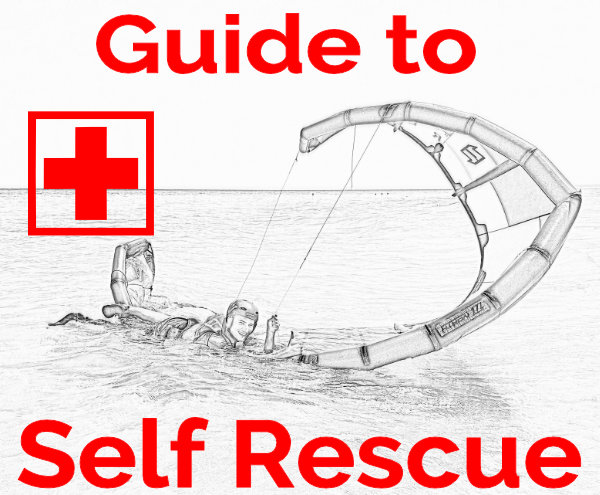
Self-Rescue in Kitesurfing: A Crucial Guide to Safety

Kitesurf Ometepe: an Epic Kite Trip to Nicaragua

Kitesurfing Spring in Andalucia: Unexpectedly Great!